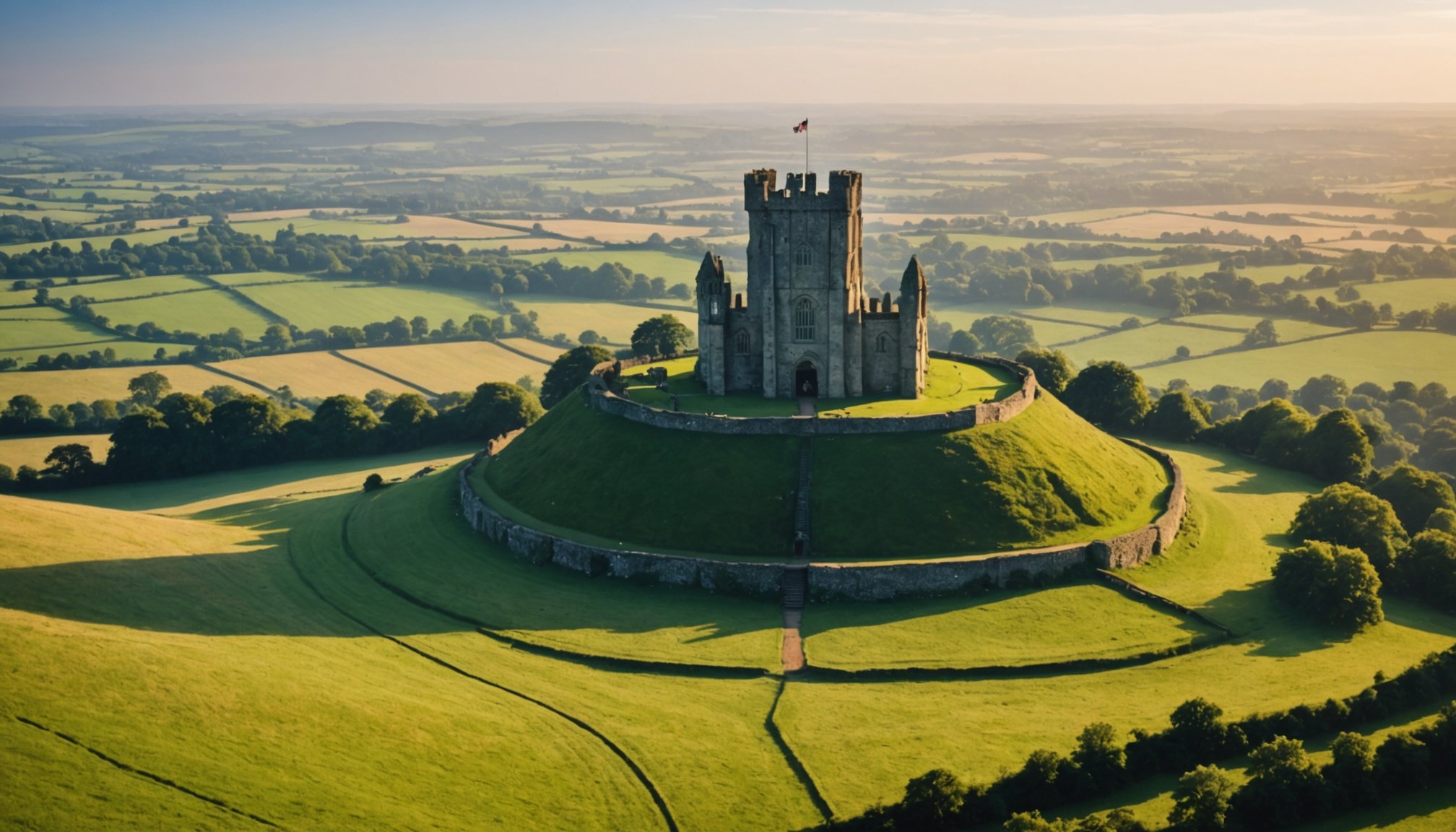Unveiling Glastonbury: Top Destinations for Discovering Ancient History and Enigmatic Legends
Glastonbury, a small town in Somerset, England, is a place steeped in ancient history, mystical legends, and spiritual significance. For centuries, it has been a magnet for pilgrims, seekers of the sacred, and those fascinated by the enigmatic tales that surround this unique location. Here, we delve into the top destinations that make Glastonbury a must-visit for anyone interested in uncovering its rich and captivating heritage.
Exploring Glastonbury Abbey: A Cradle of Christianity
Glastonbury Abbey is one of the most iconic and historically significant sites in Glastonbury. The abbey, which once stood as the second wealthiest monastery in Britain, is now a testament to the town’s rich religious and cultural history.
Also read : Top Destinations to Discover the Rich History of British Colonialism
The Founding and Early Years
According to legend, Joseph of Arimathea, who is said to have brought the Holy Grail to Britain, founded the first Christian church here around 63 AD. This church, known as the Vetusta Ecclesia or Old Church, was built on land granted by King Arviragus. Over the centuries, the abbey evolved, with significant contributions from Saxon King Ine, who constructed the first stone church in 712, and later from the Normans, who added grandiose buildings[1].
The Abbey’s Significance and Legends
The abbey is intertwined with numerous legends, including the discovery of King Arthur and Queen Guinevere’s tomb in 1191. This discovery, though likely fabricated, drew numerous pilgrims to the site, contributing to the abbey’s wealth and fame. The abbey also boasts the rare 14th-century Abbot’s Kitchen, a testament to the luxurious living of the abbot, and a museum that reveals the back-story of “England’s cradle of Christianity”[1].
Also to see : Top Insider Tips for a Memorable Experience at Hay-on-Wye”s Annual Literary Festivals
Ascending the Glastonbury Tor: A Spiritual and Historical Landmark
The Glastonbury Tor, a conical hill rising dramatically from the Somerset Levels, is another pivotal destination in Glastonbury. This hill is steeped in spiritual and historical significance.
The Tor’s Legends and Spiritual Significance
The Tor is often associated with the Isle of Avalon from Arthurian lore and is considered a site of pre-Christian worship and fertility rites. The hill is home to the remains of St. Michael’s Tower, and its terracing is believed by some to be a labyrinth leading to spiritual rebirth. The Tor is also celebrated during the Summer Solstice, attracting hundreds of spiritual seekers each year[1][3].
The Holy Thorn and Wearyall Hill
One of the most enduring legends connected to the Tor is that of the Holy Thorn. According to tradition, Joseph of Arimathea, upon arriving at Wearyall Hill, struck his staff into the ground, and it took root, growing into the sacred Glastonbury Thorn. This thorn tree, which flowers twice a year around Easter and Christmas, is a symbol of Glastonbury’s deep spiritual roots[1].
Discovering the Chalice Well and Chalice Gardens
The Chalice Well, located at the foot of the Glastonbury Tor, is a sacred source of healing and a place of profound spiritual significance.
The Well’s History and Significance
The Chalice Well is believed to be the site where Joseph of Arimathea hid the Holy Grail, the chalice from the Last Supper. The well’s waters, rich in iron, have a distinctive red hue, symbolizing the sacred feminine. The beautifully maintained gardens surrounding the well offer a peaceful retreat and are a popular spot for meditation and reflection[1][3].
The White Spring and Sacred Geometry
Near the Chalice Well is the White Spring, another sacred site in Glastonbury. Both the Chalice Well and the White Spring are part of the town’s ley lines, believed by many to be paths of concentrated spiritual energy. The area is also notable for its sacred geometry, with many structures and natural features aligning in ways that reflect ancient spiritual beliefs[3].
Walking the Glastonbury Mural Trail: Uncovering Hidden History
For those interested in a more immersive experience of Glastonbury’s history, the Glastonbury Mural Trail is an excellent way to explore the town.
The Trail’s Route and Significance
Starting at the iconic Glastonbury Tor and ending at the bustling Market Cross, the mural trail takes you on a historical journey through the town. Along the way, you can view colourful murals that depict various aspects of Glastonbury’s history, from its monastic past to its medieval trade routes. This trail provides a unique perspective on how the town has evolved over the centuries[3].
Exploring Glastonbury’s Historic Street Names: Tales of Abbey Life and Local Legends
Glastonbury’s street names are more than just labels; they are windows into the town’s rich history and local legends.
Silver Street and the Abbey’s Influence
Silver Street, once known as Cart Lane, reflects the town’s connection to the abbey. Originally named for the silversmiths who worked there during the abbey’s height, the name “Silver” is also linked to the Latin word “sylva,” meaning wood, indicating the area’s historical significance in timber trade[2].
Dod Lane and Local Folklore
Dod Lane, named after the Old English word “dod” meaning “a rounded hill,” is steeped in local folklore. The lane is associated with eerie tales, including sightings of a headless man near Bushy Combe, believed to be a nod to Abbot Whiting, who was executed on nearby Chalice Hill[2].
Bere Lane and Agricultural Heritage
Bere Lane, named after the Old English word “bere” meaning “barley,” highlights Glastonbury’s agricultural past. This lane was used to transport crops to the Abbot’s Barn, now known as Barton, reflecting the town’s old trade routes[2].
The Glastonbury Goddess Temple: A Haven for Spiritual Seekers
For those drawn to the spiritual and mystical aspects of Glastonbury, the Glastonbury Goddess Temple is a must-visit destination.
The Temple’s Purpose and Events
Dedicated to the Divine Feminine, the Goddess Temple offers various events and workshops focused on spiritual growth and self-discovery. It is a unique space for meditation, reflection, and connecting with the sacred feminine energy that permeates Glastonbury[3].
Practical Insights and Actionable Advice for Visiting Glastonbury
Planning Your Visit
When planning your visit to Glastonbury, consider the time of year. The Summer Solstice is a peak time for spiritual seekers, but visiting during other seasons can offer a more serene experience.
Must-See Attractions
- Glastonbury Abbey: Explore the ruins and learn about its rich history.
- Glastonbury Tor: Ascend the hill for panoramic views and spiritual significance.
- Chalice Well: Visit the sacred well and its beautiful gardens.
- Glastonbury Mural Trail: Walk the trail to uncover hidden history through colourful murals.
- Glastonbury Goddess Temple: Attend events or simply meditate in this sacred space.
Local Tips
- Street Names: Take a stroll through the town to understand the historical context behind the street names.
- Local Legends: Engage with local guides or residents to hear the stories and legends that make Glastonbury so unique.
- Spiritual Events: Check the local calendar for spiritual events, workshops, and festivals that align with your interests.
A Detailed List of Top Destinations in Glastonbury
Here is a detailed list of the top destinations to explore in Glastonbury:
-
Glastonbury Abbey
-
Explore the ruins and museum
-
Learn about its founding by Joseph of Arimathea
-
See the Abbot’s Kitchen and Lady Chapel
-
Understand its significance in British Christianity
-
Glastonbury Tor
-
Ascend the hill for panoramic views
-
Learn about its association with the Isle of Avalon
-
Explore the terracing and its spiritual significance
-
Attend the Summer Solstice celebrations
-
Chalice Well and Chalice Gardens
-
Visit the sacred well and its red waters
-
Explore the beautifully maintained gardens
-
Learn about its connection to the Holy Grail and Joseph of Arimathea
-
Glastonbury Mural Trail
-
Walk the trail from the Tor to Market Cross
-
View colourful murals depicting Glastonbury’s history
-
Understand the town’s evolution through its street names and landmarks
-
Glastonbury Goddess Temple
-
Attend events and workshops focused on spiritual growth
-
Meditate and reflect in this sacred space
-
Connect with the Divine Feminine energy
-
Historic Street Names
-
Explore Silver Street, Dod Lane, and Bere Lane
-
Learn about the local legends and historical context behind each name
A Comparative Table of Glastonbury’s Key Sites
| Site | Historical Significance | Spiritual Significance | Visitor Experience |
|---|---|---|---|
| Glastonbury Abbey | Founded by Joseph of Arimathea; significant in British Christianity | Associated with King Arthur and the Holy Grail | Explore ruins, museum, Abbot’s Kitchen, Lady Chapel |
| Glastonbury Tor | Pre-Christian worship site; associated with Isle of Avalon | Spiritual and historical landmark; Summer Solstice celebrations | Ascend the hill for views; explore terracing |
| Chalice Well | Believed to be the site of the Holy Grail; sacred source of healing | Sacred feminine energy; red waters symbolic of life force | Visit the well and gardens; meditate and reflect |
| Glastonbury Mural Trail | Depicts Glastonbury’s history from monastic past to medieval trade routes | Connects historical and spiritual aspects of the town | Walk the trail; view colourful murals |
| Glastonbury Goddess Temple | Dedicated to the Divine Feminine; workshops and events for spiritual growth | Sacred space for meditation and reflection | Attend events; meditate and connect with the sacred feminine energy |
Quotes and Anecdotes
- “Glastonbury is a place where the veil between the worlds is thin,” says a local guide, reflecting the town’s reputation as a site of deep spiritual energy.
- “The climb to the top of the Tor is invigorating, and the views are rewarding,” notes a visitor, highlighting the physical and spiritual benefits of ascending the hill.
- “The Chalice Well is a tranquil spot, believed to be a sacred source of healing,” explains a local resident, emphasizing the well’s significance in Glastonbury’s spiritual landscape.
In conclusion, Glastonbury is a town that seamlessly blends ancient history, enigmatic legends, and spiritual significance. Whether you are drawn to its historical ruins, its mystical energy, or its vibrant cultural scene, Glastonbury offers an experience that is both enriching and unforgettable. As you explore this magical place, remember to delve deep into its stories, legends, and spiritual essence, for it is here that the past and present converge in a way that is uniquely Glastonbury.











